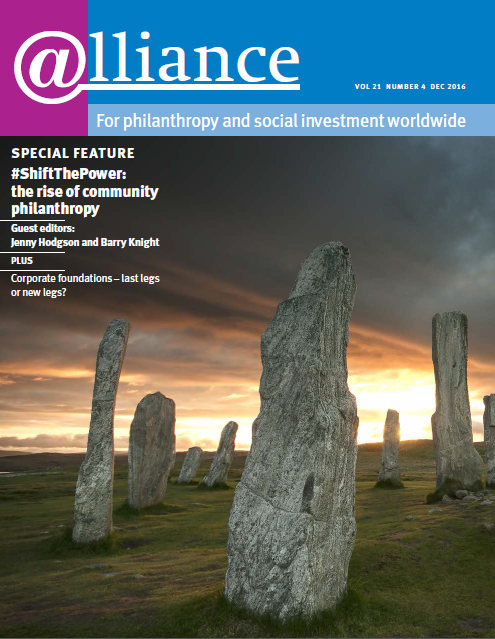A recent headline-grabbing speech claimed British foundations should raise their spending through being compelled to spend a mandatory proportion of annual capital assets[1].The claim suggested that foundations are ‘warehousing’ assets that could be put to public use today. This call was disappointing, not least because the positive value of what foundations contribute to so many public spheres is less often heard. The speech was lacking in any evidence that a mandatory spending formula would increase foundation spending or make it more effective.
Policy speculation needs to be reined in, at least until there is more evidence. Together with colleagues, I have been analysing figures based on financial data compiled for the recent Foundation Giving Trends 2016 [2]. Our provisional analysis shows that there is no discernible evidence of any potential benefit from imposing spending rules[3]. Rather such rules might also put at risk foundations’ ability to make larger or one-off investments.
The obvious starting point for this research was to apply the well-established US mandatory distribution figure of 5 per cent of the value of the foundation’s endowment to published UK accounts data. However, important ‘health warnings’ are necessary. Results can only be notional, because the ‘5 per cent’ calculation in the US is an actual audited (or auditable) figure, while research calculations based on published data are somewhat ‘rough and ready’. The asset values used, for example, represent a single annual snapshot taken from UK annual reports, and not management accounts figures, with their monthly and quarterly fluctuations. They may also include some assets not used for directly charitable purposes. Other issues include variations between the US and UK in accounting practice and a lack of detailed UK spending data.
It is clear that the next generations in Western Europe will be less well-off than their parents, with higher pensionable ages and housing costs, and lower savings, welfare provision and job security, though future needs are not the only consideration. Our understanding of how to cure society’s problems is highly imperfect, or we would have done it by now.
Bearing these limitations in mind, results for the largest 200 UK foundations show an average annual charitable expenditure of 5 per cent or more of the group’s total asset value is consistently achieved. The figure includes grants, charitable programmes, some support costs and programme-related investments. It varied from 5 per cent to 6 per cent from 2010 to 2015, generally showing foundations as a group exceeding expectations.
The data also confirm what we already know, namely the substantial diversity and flexibility in foundations’ use of resources. Over half spent above the 5 per cent average. One example is the Esmée Fairbairn Foundation which, like some other large trusts, has adopted a policy of spending more than annual investment income, particularly in times of need. A minority (14 per cent), with just one-tenth of the assets, spent less than 3 per cent. Examples include the Gosling Foundation, which made major investments in previous years for the preservation of HMS Victory, the UK’s flagship at the Battle of Trafalgar. Factors underlying variable spending rates include lower spending levels preceding or following one or two very substantial grants, and spending down capital at an apparently high but obviously time-limited level.
Results for the largest 200 UK foundations show an average annual charitable expenditure of 5 per cent or more of the group’s total asset value is consistently achieved.
The data cast serious doubt over whether formulaic spending rates have any value at all. A number of foundations spend at a relatively steady annual rate somewhere between 3-5 per cent, aiming to provide consistent annual support for beneficiaries, and preserving a funding base for the future.
It is clear that the next generations in Western Europe will be less well-off than their parents, with higher pensionable ages and housing costs, and lower savings, welfare provision and job security, though future needs are not the only consideration. Our understanding of how to cure society’s problems is highly imperfect, or we would have done it by now.
Foundations’ asset base guarantees their independence and capacity to move into the spaces where state policy fails, and provides future-proofing for investment in change and progress. Mandatory spending rules would not only be unlikely to generate higher spending overall but could put at risk foundations’ capacity to be proactive, respond to needs and opportunities in flexible ways, and take both long and short-term perspectives.
Cathy Pharoah is co-director of the Centre for Giving and Philanthropy, Cass Business School, City University London.
Email catherina.pharoah.1@city.ac.uk
For more discussion on philanthropy payouts, check out Alliance Audio: Philanthropy Payouts.
Footnotes
- ^ http://tinyurl.com/RookerSpeech
- ^ https://www.civilsociety.co.uk/news/foundations-should-have-to-spend-a-minimum-amount-says-charities-committee-lord.html
- ^ Work in progress for publication in 2017, Cathy Pharoah and Jenny Harrow with Tobias Jung.







Comments (0)